If you’re like us, you’ve invested time and dollars into a well-curated skincare routine that addresses every single concern. While your routine may seem foolproof, there is no combination of products to help you fully escape dehydrated skin. Unforeseen lifestyle and seasonal changes can cause flaking, scaliness, dullness and even itchiness seemingly out of nowhere. It all adds up to a major bummer (especially if you have that well-regimented routine). The good news is there are plenty of easy fixes to get you smooth and radiant again.
So, What is Dehydrated Skin?
While dehydrated skin and dry skin sound like the same thing, they're the cousins of the skincare world. Dehydrated skin lacks water. It’s your skin in a temporary state signaling that it needs hydration. Dry skin is a skin type you’re typically born with, though it can change with age or the seasons. It means your skin lacks natural oils or sebum.
Other skin types are normal, combination, and oily. Tackling each requires a unique approach that we’re here to lay out for you.
How to Tell If Your Skin is Dehydrated
If your skin lacks hydration, it will send out certain SOS signals. Let's dive into the tell-tale skin dehydration signs.
Looks Oily but Feels Dry
Dehydrated skin does not hold onto moisture the way skin should. When your skin senses this moisture loss, it ramps up oil production to balance it out and works to lock in whatever water it can. If you notice some dry patches mixed with a bit of oiliness, it's your skin trying to find balance.
Dull Skin
One of the most noticeable dehydrated skin symptoms is skin that looks dull or even wan. This means that your skin is sporting a layer of dead skin cells that’s giving off a grayish tint and potentially clogging pores.
Sensitive
One of the other characteristics of dehydrated skin is that your protective barrier isn’t doing its usual job of shielding skin from bacteria and pollution. This leads to skin feeling more sensitive than usual––a reaction you might see even with your go-to skincare products.
Itchy or Scaly
Exposure to extreme temperatures, whether from weather or indoor heating and cooling, can strip moisture from your skin. This creates itching, a tight sensation, and even skin peeling.
The Pinch Test
Fun fact: You can determine your skin’s hydration levels right now where you’re sitting. Take a small portion of your skin around one of your cheeks and lightly pinch. If the skin doesn’t immediately bounce back when you let go, then it might be dehydrated.
Side Effects of Dehydrated Skin
A few unwanted side effects can surface if you don’t address dehydration. Let’s find out what they are.
Breakouts or Acne
Dehydration increases the likelihood of enlarged pores, which allow acne-causing germs to penetrate deep into your skin.
Redness
If neglected, skin dehydration can lead to rashes, cracked skin, and redness.
Inflammation
Severe skin dehydration can cause inflammation or worse, rashes that are difficult to identify and treat.
Congestion
Dehydration enables dead skin cells, sweat, pollutants, and sebum to accumulate in enlarged pores, which in turn, causes congestion.
Increased Skin Sensitivity
Dehydration makes your skin more sensitive and prone to inflammation. Skin sensitivity shows up as rashes, dry areas, and redness.
How Dehydration Shows Up in Different Skin Types
Dehydration doesn't play favorites. Let's explore how it makes itself known across different skin types.
Balanced Skin
If your skin is normally well-balanced, it’s easy to tell when something is off. When your skin suddenly feels tight and papery, then it could very well be dehydrated. Fine lines that suddenly appear are dehydration lines. Other signs are skin that looks more sunken and darker eye circles.
Dry Skin
If you have dry skin, then you might see signs of both dryness and dehydration––including a dull appearance. Because dry skin tends to be thin, lines may show up more easily and be more visible than on oilier types.
Oily Skin
With oily skin, dehydration can lead to a combination look and feel. When your skin senses it lacks water, it produces more oil to compensate. Next time you see excess oil on your skin, it could be a sign it’s dehydrated.
Sensitive Skin
When your skin feels more sensitive than normal, or you get sudden breakouts, this could point to dehydration. The more dehydrated the skin, the less protection there is making it hypersensitive, redder, and more irritated than usual.
Dehydrated Skin Treatment
Now that you’ve learned what it is, you may be wondering how to fix dehydrated skin. Knowing whether your skin is dry or dehydrated will help determine which specific products you add to your routine/
Moisturize, Moisturize, Moisturize
Soothing dehydrated skin takes the right kind of moisturizer. As the final step in your skincare routine, apply a rich, nutrient-rich lotion or cream. That’s your go-to move for blissfully hydrated skin.
Ceramides are lipids (aka fat molecules) that help your skin retain moisture. Dryness and irritation happen when your skin lacks ceramides. Look for a body cream that replenishes them, like Delicia Body Cream. This whipped, ultra-rich body butter supports the skin's barrier and penetrates deep below the surface to lock in moisture and relieve extra dry skin.
Weekly Exfoliation is Key
Make exfoliation a weekly ritual when your skin needs moisture. Unwanted dead skin cells camp out on your skin’s surface, keeping it from properly absorbing products.
Dehydrated Skin Cleared Up
By now you know dry skin is a condition, and dehydration is a temporary state. Wherever you fall, constant hydration will keep both at bay.
At Skincare & Co we have a range of products that can treat dehydrated skin. Check our catalog or get in touch with us if you have any questions when choosing products and want us to highlight which would best work for you!

